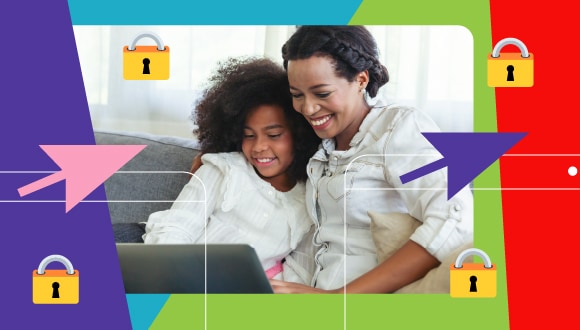The children of the 2020s are online more than any generation before them. Everything from their phones, to their TVs, to their gaming systems can connect to the internet.
Since kids are online more than ever, it’s important that they know how to use the internet safely. There are simple practices kids can learn today to prepare them for a lifetime of cyber security. Here are a few things you can teach kids to look out for when they’re online.
Phishing isn’t just for adults
Phishing is a tactic that cyber criminals use to steal personal and financial information from their targets. It’s one of the most common cyber threats to Canadians today. While phishing typically happens over email or text messages (which is called smishing), it can happen just about anywhere online.
Even if they’re too young for their own cell phone or email address, children can be targeted by scammers pretending to be other players in video games and friends on messaging apps. They can also be targeted on social media apps like YouTube or TikTok. Phishing messages might include:
- Offers of prizes in exchange for personal information
- Links to malware disguised as “free” games or add-on content (in-game items usually purchased with real-world money)
- Requests for personal information disguised in a fun way (“Did you know that your superhero name is your mother’s maiden name plus the street you live on? Post yours!”)
Kids today are known for being tech-savvy but knowing how technology works doesn’t protect them from phishing. Teach kids to be wary of requests for information, no matter how good the offer is or how innocent the request sounds. It’s the best way to prevent a child from falling for a phishing scam.
Oversharing can lead to compromised accounts
When it comes to the internet, not every piece of information needs to be stolen for a criminal to get access to it. If kids aren’t careful with what they share online, they could be doing a cyber criminal’s work for them.
Children don’t always know what information is safe to share and what isn’t. For example, telling everyone at school that it’s your birthday may be a cool thing to do, but sharing that same information online might not be. The same goes for other details that might seem less harmful than they actually are, like their full name, what school they go to or what city they live in.
Chances are your child’s passwords contain small personal details a cyber criminal would be able to find in the content they share online. By letting kids know to keep that information to themselves and by teaching them to use strong and unique passphrases and passwords, you can help them keep their accounts and devices secure.
Malware might look appealing
Malware, short for malicious software, is a type of program that infects your computer or phone with the intention of causing harm. Malware is used to damage or destroy your device, allow cyber criminals to spy on you, steal your personal information or hold your files for ransom.
Malware is often downloaded through programs or files that seem legitimate. For example, kids might accidentally download malware while trying to install games or apps on their devices.
It’s important for parents or guardians to take steps to prevent their children from downloading malware. One thing you can do is enable parental controls to restrict what can be downloaded and installed from the internet. You can also encourage kids to ask your permission before downloading or installing any file, and make sure those files are only downloaded from verified sources. And, since we know it’s impossible to keep an eye on kids 24/7, you should install anti-virus software on all your family’s devices for an extra layer of protection.
Conclusion
The internet is home to all sorts of fun content that appeals directly to kids. By teaching them simple steps they can take to stay safe online, you can help keep online activities enjoyable, educational and cyber safe for your entire family.
